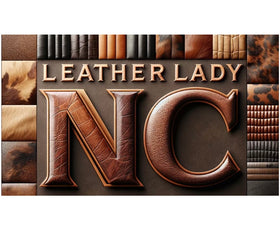
How to Identify Quality Leather and Avoid Fake Leather
When you’re buying leather whether it’s a hide for crafting, a jacket, or a new sofa it’s easy to get fooled. The market is flooded with “genuine leather” labels that sound trustworthy but often cover up poor-quality materials. If you want leather that lasts, smells right, and feels right, here’s how to tell the difference between the real deal and cheap imitations.
1. Understand the Leather Grades
Before anything else, know the terminology.
-
Full-Grain Leather: The best of the best. It includes the entire hide, with all its natural imperfections. It develops a rich patina over time and can last decades.
-
Top-Grain Leather: Slightly sanded to remove imperfections, giving it a smoother finish. Still high quality and durable, but not quite as natural as full grain.
-
Genuine Leather: The most misleading label in the industry. It’s technically real leather but usually made from leftover layers of hide that have been heavily processed. It’s cheap and won’t age well.
-
Bonded Leather: Scraps of leather fibers glued together and coated with polyurethane. Think of it like particle board — made from the leftovers, not the solid wood.
If a label says “Genuine Leather,” that’s your warning sign. It’s often code for “barely leather.”
2. The Touch Test
Real leather feels like skin — flexible, soft, and warm to the touch. Fake leather feels too smooth or plasticky, and often cold.
Press your thumb into it:
-
Real leather will stretch slightly and show natural wrinkles.
-
Fake leather will stay stiff or show an unnatural uniform grain pattern.
Quality hides also tend to have slight imperfections or variations — that’s a good thing. Perfectly even texture usually means it’s synthetic.
3. The Smell Test
This one’s simple.
-
Real leather smells earthy, rich, and organic.
-
Fake leather smells like chemicals or plastic.
If it smells like something from a dollar store, it’s not full-grain leather.
4. The Pore Pattern
Look closely. Real leather has irregular, uneven pores and patterns. Fake leather often has machine-stamped pores that repeat in a perfect pattern.
-
Tip: Use a magnifying glass if you’re unsure. Natural grain always has randomness.
5. Check the Edges
High-quality leather edges are rough and fibrous. Faux leather edges are smooth and even, sometimes with a plastic coating.
When you cut or sand a real hide, you’ll see those natural fibers that tell you it came from an animal, not a machine.
6. The Water Drop Test
Put a single drop of water on the leather.
-
Real leather will absorb it slowly, darkening slightly as it soaks in.
-
Fake leather will repel the water and leave it beaded on the surface.
This is one of the quickest ways to tell what you’re dealing with however manufacturers can put a coating on the leather to keep water from absorbing. This is especially true for upholstery leather.
7. The Price and Source
If the price seems too good to be true, it is. Full-grain leather costs more because it lasts decades and gets better with age.
Buy from reputable sellers especially those who identify the tanning method (vegetable-tanned, chrome-tanned, etc.) and source. If they’re vague, be skeptical. FYI: High Point, NC is the "furniture capital of the world" we buy leather from a variety of furniture companies that specialize in leather upholstery as well as companies that sell full hides. While our leather remnants do vary in quality, since if varies from one manufacturer to another, we don't buy bonded leather. 99% of ours is full and top grain.
8. Bonus: Learn to Spot the Marketing Tricks
Some manufacturers love to use confusing language:
-
“Man-made leather” = synthetic.
-
“Vegan leather” = plastic (usually polyurethane or PVC, sorry Tesla owners).
-
“Eco leather” = meaningless unless the brand explains their process.
When in doubt, ask what the leather is made of and how it was tanned. If the seller can’t tell you, they probably don’t want to.
In Summary
Quality leather tells a story. It has imperfections, texture, and a smell that fake materials can’t imitate. It’s durable, breathable, and timeless — worth paying for and caring for.
So next time you’re shopping, trust your senses: look, touch, smell, and ask questions. Real leather doesn’t hide behind labels — it proves itself.
One other point that I hear A LOT, that now cows are being killed for a leather couch. The truth is no cows are killed for their leather. That steak or hamburger you ate this week, you know the rest. The leather hide is what is leftover. It would either be tossed into a landfill or turned into leather that lasts for years. The choice is ours.
